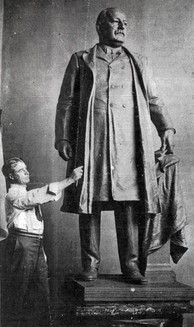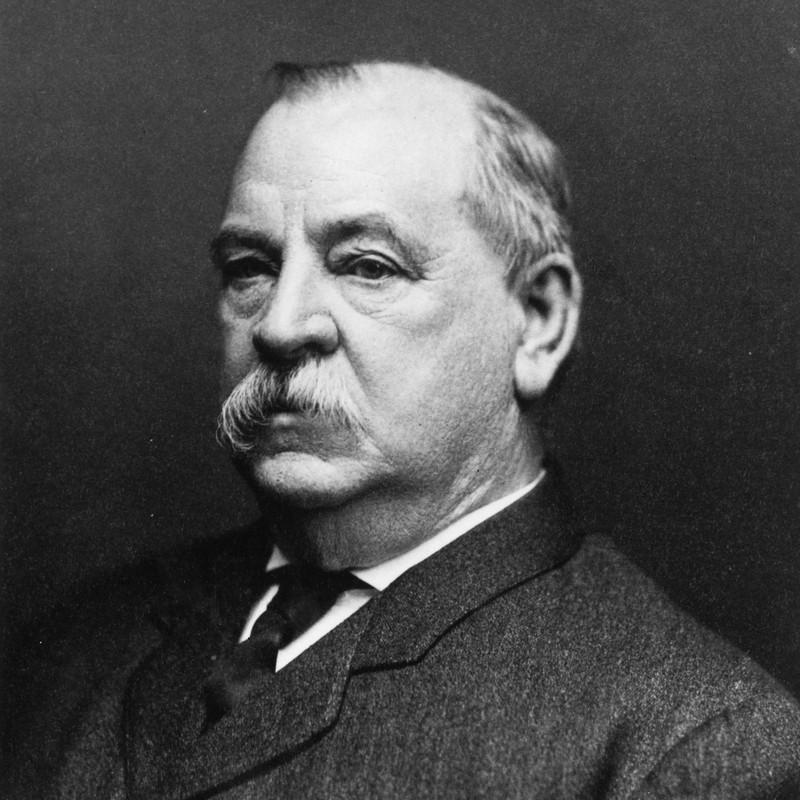Grover Cleveland Statue
Introduction
Text-to-speech Audio
This statue commemorates the twenty-second and twenty-fourth President of the United States, Grover Cleveland (1837-1908). A native of New Jersey, he was mayor of Buffalo and governor of New York before becoming President of the United States, serving from 1885 to 1889 and again from 1893 to 1897. Cleveland is the only U.S. president to serve two non-consecutive terms and the only one to have been married in the White House. On July 1, 1932, in the course of its centennial celebration, the City of Buffalo officially dedicated the new Buffalo City Hall. Additionally, it dedicated a statue of Cleveland at the building’s northeast corner. Designed by New York artist Bryant Baker, the larger-than-life-sized bronze sculpture depicts Cleveland standing, dressed in a suit and overcoat. Looking out onto the horizon, he holds a small stack of papers in his left hand, which rests on a short, draped column. Money from a fund bequeathed to the City by prominent Buffalo attorney James G. Forsyth paid for the statue, the first erected to Cleveland in the United States.
Images
Bryant Baker poses for a picture with his model of the statue in 1930

Grover Cleveland (1837-1908)

Backstory and Context
Text-to-speech Audio
Stephen Grover Cleveland was born in this house in Caldwell, New Jersey on March 18, 1837. He was one of nine children born to Richard Falley Cleveland, a Presbyterian minister, and Ann (Neal) Cleveland. In 1841, the family moved to Fayetteville, New York. At the age of thirteen, Cleveland’s father fell ill, forcing him to drop out of school and begin working to support the family. A few years later, his father died. Sometime in the 1850s, Cleveland began working as a clerk at a law firm in Buffalo, where, in his spare time, he read law. In 1859, he was admitted to the bar. During the Civil War, Cleveland was drafted, but hired a substitute so that he could stay behind and care for his widowed mother. Through hard work and determination, he rose to prominence in the buffalo legal community and became assistant district attorney of Erie County in 1863. Seven years later, Cleveland became the county’s sheriff. He would serve in the position until 1873.
In 1881, Cleveland received the Democratic Party’s nomination for mayor of Buffalo. He won the race handily. As mayor, Cleveland earned a reputation as an opponent of corruption and wasteful spending. Only a year after winning Buffalo’s mayoral election, and despite being not well-known outside of Erie County, he secured the nomination of his political party for governor of New York. This race, too, he won easily. Two years later, in 1884, Cleveland won the Democratic Party’s nomination for president. In a very close election, he defeated Republican candidate James G. Blaine. With his victory, Cleveland became the first Democratic to win a presidential election since before the Civil War.
While in the White House, Cleveland built on his record of fighting corruption and wasteful spending. He vetoed fraudulent Civil War pension bills and investigated the western land claims of railroad companies. He also signed the Interstate Commerce Act and called for a lowering of tariffs. In 1886, Cleveland married twenty-one-year-old Frances Folsom. She was twenty-seven years his junior. To this day, he is the only president to have been married in the White House. Two years later, Cleveland ran for reelection. Despite winning the popular vote, he lost to his Republican challenger Benjamin Harrison in the Electoral College tally.
After his defeat to Harrison, Cleveland went to work at a prestigious law firm in New York City. He, however, would not stay out of the national political spotlight for long. In 1892, Cleveland secured the Democratic Party’s nomination for president. In a rematch with Harrison, he won handily. With his victory, he became the only U.S. president to serve two non-consecutive terms.
The economy dominated Cleveland’s second term. In 1893, the United States suffered the most severe economic downturn in its history to that point. Cleveland’s inability to solve the economic crisis, coupled with his refusal to provide direct aid to suffering Americans, caused his popularity to plummet. In 1896, with Cleveland eligible to run for reelection, the Democratic Party snubbed the sitting president by nominating William Jennings Bryan instead. After leaving the White House in 1897, Cleveland retired to Princeton, New Jersey, where he lectured and served as a trustee of Princeton University. On June 24, 1908, he died at the age of seventy-one. His remains were buried in Princeton Cemetery.
On July 1, 1932, in the course of its centennial celebration, the City of Buffalo officially dedicated the new Buffalo City Hall. Additionally, it dedicated a statue of Cleveland at the building’s northeast corner. Designed by New York artist Bryant Baker, the larger-than-life-sized bronze sculpture depicts Cleveland standing, dressed in a suit and overcoat. Looking out onto the horizon, he holds a small stack of papers in his left hand, which rests on a short, draped column. Money from a fund bequeathed to the City by prominent Buffalo attorney James G. Forsyth paid for the statue, the first erected to Cleveland in the United States.
Cite This Entry
Curran, Francis and Clio Admin. "Grover Cleveland Statue." Clio: Your Guide to History. February 13, 2025. Accessed April 14, 2025. https://theclio.com/entry/136981
Sources
"Death of James G. Forsyth." The Metal Worker 59, no. 13 (March 28, 1903): 40-41. <https://www.google.com/books/edition/Sanitary_Heating_Engineering/4saiA9o5lU4C?hl=en&gbpv=1&dq=james+g.+forsyth+buffalo+ny&pg=RA13-PA40&printsec=frontcover>.
Freidel, Frank and Hugh S. Sidey. The Presidents of the United States of America. Washington, DC: White House Historical Association, 2006.
Goldman, Mary Kunz. "Walking in footsteps of Buffalo presidents." The Buffalo News, February 17, 2014 <https://buffalonews.com/news/local/walking-in-footsteps-of-buffalo-presidents/article_0e9fa8f5-657d-5677-abe5-5132686cbc95.html>.
"Grover Cleveland." Encyclopaedia Britannica. Web. 3 July 2021 <https://www.britannica.com/biography/Grover-Cleveland>.
https://www.wnyhistory.org/portfolios/men/grover_cleveland/grover_cleveland.html
https://www.whitehouse.gov/about-the-white-house/presidents/grover-cleveland/

